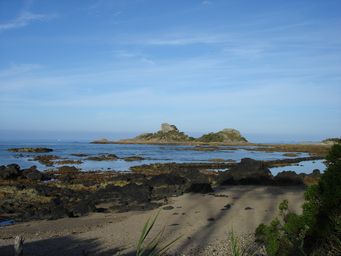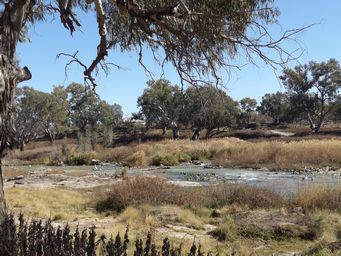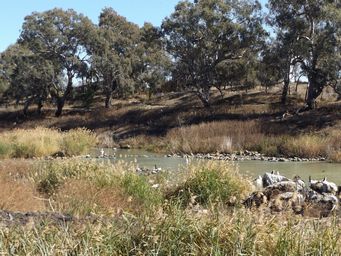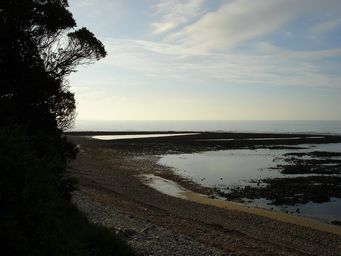Australia So Much to See


Use your browser back button to return to the page you were reading
Historical accounts, oral traditions and ethnographic observations reveal that at the time of the British colonisation of Australia at least 19 different species of plant were being cultivated by at least 21 different identifiable indigenous groups. These included species of yam, sweet potato and its relatives (such as the "bush potato"), "native millet", ngardu, "bush tomatoes" and "bush onions".
When explorer George Grey first entered the Victoria District of the central west coast of Western Australia in 1839, he noted yam fields of square kilometres in extent. One tract "extended east and west as far as we could see". Further south he recorded that "the whole of this valley is an extensive warran [yam] ground".
Grey also reported four villages in the region, two of which he observed at Hutt River the day after encountering the yam fields. These villages comprised dwellings that were "very nicely plastered over the outside with clay, and clods of turf," and which Grey thought "were evidently intended for fixed places of residence".
In the Corners Region of eastern central Australia, in an arc from western New South Wales through south-west Queensland, north-east South Australia and the southeast of the Northern Territory - a similar pattern was evident when Europeans began to intrude into those areas. Here there is evidence that native millet, ngardu and bush onions were sown by broadcast seeding.
Augustus Gregory in south-west Queensland in 1864: "Fields of 1,000 acres [400 hectares] are there met with growing this cereal. The natives cut it down by means of stone knives, cutting down the stalk half way, beat out the seed leaving the straw which is often met with in large heaps."
Surveyor Lewis made a similar observation in 1875 about the "nardoo flats" of the Mulligan River in south-west Queensland "extending northward as far as the eye could reach". Likewise John Davis, who was searching for Burke and Wills in the Strzelecki Desert in 1861, noted that ngardu "is procured in almost any quantities in the flooded flats by sweeping it up into heaps".
Sturt, another explorer of some note, recorded in his journal on the upper Darling River on 5 February 1829: "Early in the day we passed a group of seventy huts, capable of holding twelve to fifteen men each. They appeared to be permanent habitations, and all of them fronted the same point of the compass." If fully occupied, such a "permanent" settlement would have had a population of 800-1000 residents.
Extracts from Evidence for Indigenous Australian Agriculture written by Rupert Gerritsen and published in Australian Science in the July/August edition.
Other explorers also recorded agriculture and village living.
When Major Thomas Mitchell first made his way through the Port
Phillip district in winter of 1836 he was struck by how much some of the landscape resembled Europe.
"The world of the Australians
was as moulded by conscious human action as were the hedgerowed fields of England. If one used the plough and the iron axe to shape
their world, the other used fire and the stone axe."
According to archaeologist, Heather Builth:
"The Gunditjmara weren’t
just catching eels, their whole society was based around eels. The villages associated with the Lake Condah fish farm were actually
more like company towns, with dwellings built to house the people who worked the farms. It’s like you have your council houses for
the factory. That’s what was going on here."
"This system was used to farm huge quantities of eel, enough to feed up to 10,000 people."
Extracts from State Library of Victoria Indigenous land use.
The findings, by the anthropologist and architect Dr Paul Memmot, of the University of Queensland, discredit a commonly held view
in Australia that Aborigines were completely nomadic before the arrival of Europeans 200 years ago.
Dwellings were constructed
in various styles, depending on the climate. Most common were dome-like structures made of cane reeds with roofs thatched with palm
leaves.
Some of the houses were interconnected, allowing native people to interact during long periods spent indoors during the
wet season.
In western Victoria, Aborigines built circular stone walls more than a metre high, constructing dome roofs over the
top with earth or sod cladding.
Extracts from The Guardian Scientist debunks nomadic Aborigine 'myth'
Ancient Aboriginal Culture and connection with Australia
Devil’s Lair: Limestone cave south-west Western Australia – 41,000 to 46,000 years old.
Lake Mungo: Dry lake basin,
Willandra Billabong Creek, western NSW 43,000.
Source Journal of Archaeological Science
Katjarra, or the Carnarvon Ranges, in the Little Sandy Desert of Western Australia: Analysis of charcoal from ancient campfires in Western Australia show the rock shelter was first visited at least 50,000 years ago.
Pilbara: Most recently the discovery of the artefacts of animal bone and charcoal at the Ganga Maya Cave in the Pilbara region of Western Australia are the subject of a scientific paper not yet submitted to archaeological journals. The items analysed through carbon-dating techniques indicate first use of the cave from more than 45,000 years ago. Read more: Archaeological Cave Dig
Barrow Island: Testing of artefacts in an island cave in northern Western Australia has established some of the oldest occupation dates recorded in Australia, proving Aboriginal Australians were living in the now largely submerged northern coast 50,000 years ago.
Kangaroo Bone tools
dated: Eight tools made from kangaroo bone have been excavated from Riwi Cave in the southern Kimberley, by archaeologists in
the early 1990s with support from the nearby Mimbi community. It's only now that better dating techniques could put the tools
at between 35,000 and 46,000 years old.
What is the oldest known structure in Australia?
Fish traps are found in waters through Australia, but no others recorded
are as old as those at Brewarrina in New South Wales. See more on our visit to Brewarrina.
The Brewarrina fish traps are
estimated to be over 40,000 years old and one of the oldest man-made structures on earth. This elaborate network of rock weirs and
pools stretches for around half a kilometre along the riverbed. From Visit New South Wales
The intricate design
of the dry-stone rock weirs and pens allowed large numbers of fish to be herded and caught, particularly during spring migrations.
The design also allowed the fish traps to resist damage during both high and low river flows.
See this and more on National Heritage
Places.




Bruce Pascoe is an Australian historian and author. His research has revealed that Aboriginals were not just nomadic hunter
gathers prior to white settlement in Australia, but lives in structured dwellings and sowed crops, including grasses which were harvested
and seeds stored for grinding into flour. Early settlers and explorers noted some of these observations.
Historian
Bruce Pascoe has spent years looking through these incredible accounts and found the first white settlers documented how Aboriginal
people built homes, villages, parks, dams and wells, selected seeds for harvesting, ploughed fields, irrigated crops and preserved
food in vessels.
Grinding stones found near Wilcannia in New South Wales have had flour remnants dated to being between 30,000
and 42,000 years old are reported in different references. This well and truly pre-dates bread making in ancient Egypt around
15,000 years ago, previously thought to be the first in the world.
Extract from News.
A number of interviews with Bruce Pascoe are linked here.
Not only did Aboriginal people farm, they conserved water to enable them to survive in the harsh Australian climate.
“The
study, which is the first of its kind, indicates Aboriginal people had extensive knowledge of the groundwater system, says hydrogeologist
Brad Moggridge, knowledge that is still held today.”
Extract from Aboriginal people built water tunnels